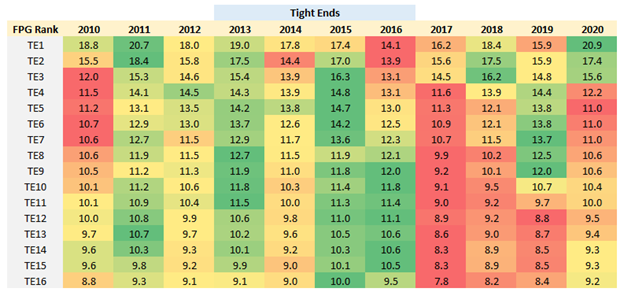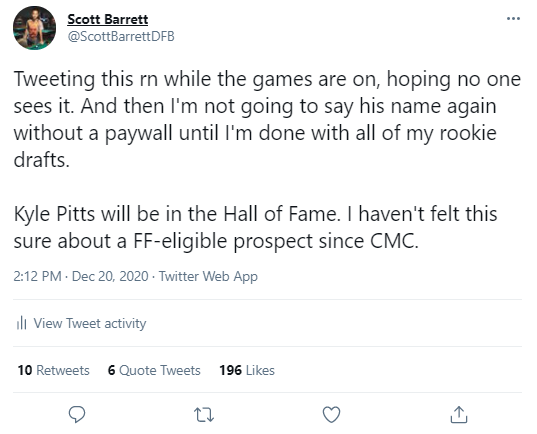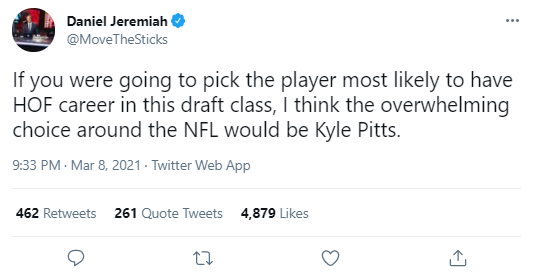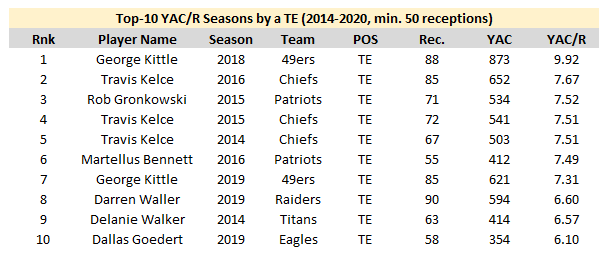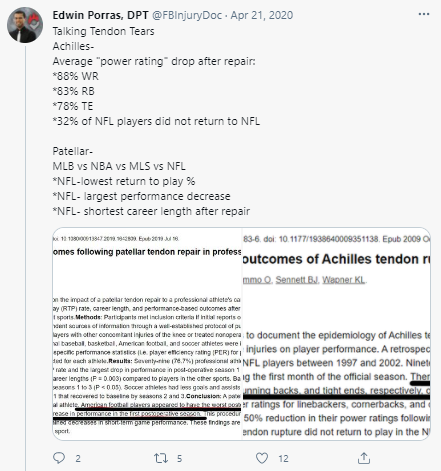A lot of work goes into my dynasty rankings.
I’ll say this to my editor, as he anxiously awaits an article to be filed, and he’ll just nod his head and then walk away.
No really, a lot of work goes into my dynasty rankings.
Phase I of my rankings process starts with Phase I of my model —which has three phases in all. Phase I focuses on college production. Phase II focuses on height, weight, and athletic measurables. Phase III focuses entirely on draft capital.
Early on, I try not to be influenced by subjective factors – industry mock drafts, rumors regarding 40-yard-dash times, and the like. Instead, I focus solely on the objective – a player’s cold, hard, brutally honest numbers. I’ll run each player’s college statistics through my model (which focuses only on the most predictive metrics for each position) for an initial ranking. Who leads this class? How does that player compare to the leaders of previous classes? Consider this ‘Phase I’ of my model, which you can take as something akin to a production (plus efficiency) score.
Then, these rankings get updated again following the Combine (or, for 2021, after every player’s Pro Day). Each participant’s numbers (e.g. height, weight, 40-time, broad jump, etc.) get parsed through a second version of my model that focuses only on the most predictive measurables and events for each position. This has a small (probably much smaller than imagined) but real impact on the first model. We’ll call this Phase II.
The actual NFL Draft then has the biggest impact on these rankings, as draft position is the variable with the single most predictive power at any position. That alone comprises Phase III and the completion of my model.
Once my model is concluded I’ll welcome in the subjective factors, and small tinkerings will be made to my rankings. What did Greg Cosell think of this player? How enticing is this landing spot for this player’s fantasy potential? How accurate is his quarterback? How run-heavy (historically) is the offensive play-caller? Countless hours will be spent watching Post-Draft Press Conferences with a team’s head coach, offensive coordinator, and/or general manager. Why did they draft this player? Do they like this tight end more as a receiver or a blocker? Do they think they can contribute immediately in Year 1? Etc.
In this week’s series, I’ll be walking you through the first step in this process, breaking down my top tight ends, running backs, and wide receivers according to my pre-Combine (or, again pre-Pro Day) prospect model. In today’s article, we’ll be focusing on the top tight ends of the 2021 Draft class. Notes: You can read last year’s articles here (running backs), here (wide receivers), and here (tight ends).
Tier 1
1. Kyle Pitts, TE, Florida Gators (Age: 20.5)
Where he ranks: The model views Pitts as the best TE prospect since at least 2015. And 26% better than the next-closest TE (Evan Engram) over this span.
Key Quote:
“I'm no fan of drafting a tight end early… The good news is that Pitts would still be a first-rounder if you just called him a wide receiver.” – Mike Renner (PFF)
Why he ranks here:
You’ve heard me talk about Bell Cow RBs. You’ve heard me talk about Konami Code QBs. I don’t know what to call them, but there needs to be a distinction between the highest echelon of the TE position (those putting up numbers which would rank top-15 at the WR position) and everyone else.
Consider Travis Kelce, who posted the highest win-rate of any individual player in BestBall10s last year (24.4%). On a fantasy points per game (FPG) basis, Kelce was 90% more productive than the No. 5 highest-scoring TE. For perspective, Tyreek Hill (the No. 2 highest-scoring WR) was only 89% more productive than the No. 43 highest-scoring WR (Nelson Agholor). Relative (i.e. positional) value matters, and the TE position is ruled by a wealthy elite (2-4 TEs) while everyone else lives well below the poverty line.
Within that highest tier (the oligarchs) you’ll find two different archetypes. There’s the “move” TE archetype (think Kelce and Darren Waller) — WRs masquerading as TEs. Neither Kelce or Waller are very effective blockers, or are asked to block very often, which is actually a big positive for fantasy – you don’t earn fantasy points per successful block, you can only earn fantasy points when running routes.
In 2020, Kelce spent 55% of his snaps lined up in the slot or out wide and was only asked to block on 7% of his passing snaps. Compare that to George Kittle (at 27% and 15%, respectively). That’s a massive advantage for someone like Kelce, running 37.9 routes per game to Kittle’s 27.9 — there’s 36% more opportunities to accrue fantasy points.
The other archetype would be the “Y” — or “in-line” — TE (think Rob Gronkowski and Kittle at the highest end of that spectrum). They’re at a disadvantage in comparison to the move TEs, but can still produce like the move TEs, they’ll just need to be as hyper-efficient as Kittle and Gronkowski to do so (a tall order, and maybe a near-impossibility for anyone not-named Kittle or Gronkowski – two all-time outliers).
Think of Pitts similarly to Kelce or Waller — he’s a WR masquerading as a TE, as evident by his 96.3 YPG average on a WR-like 13.9 average depth of target (aDOT) in 2020. There’s also been talk that some NFL teams view him as a WR. He’s a capable blocker, but that’s not going to make him a top-10 pick – the reason his name will be called early is because he’s a dominant receiver. You can think of Pitts like Kelce or Waller, but maybe better yet, you should think of him as a Round-1-caliber WR who comes with a TE designation for fantasy. Again, that’s huge – 15.0-plus FPG is worth a lot more at the TE position than the WR position.
Bonus Stats:
Pitts posted 43/770/12 receiving in 2020 (8 games, 65 targets) and 54/649/5 in 2019 (13 games, 80 targets).
PFF awarded Pitts with a 97.0 overall grade in 2020, the highest grade they’ve ever awarded to a college TE. Next-closest were Dallas Goedert in 2017 (95.5), Adam Trautman in 2019 (95.2), and George Kittle in 2015 (94.6). More impressive, his 96.7 receiving grade is the highest grade they’ve awarded to any player at any position.
Pitts set the PFF record for yards per route run by a TE, averaging 3.26 YPRR in 2020. The next-best seasons were from Harrison Bryant in 2019 (3.04) and Dallas Goedert in 2017 (2.93), though neither played in the Power-5 like Pitts.
Pitts averaged 96.3 YPG in 2020, the best age-adjusted season by any TE since at least 2000.
In 2020, Pitts ranked behind only Devonta Smith in YPRR against man coverage (4.91), and ranked well ahead of the next-closest TE (Brevin Jordan, 2.93). He also led all TEs in YPRR when lined up out wide (2.36).
Bottom Line:
Pitts is going to be an absolute cheat code for fantasy. He’s the best fantasy prospect we’ve seen from a TE, potentially ever.
In dynasty rookie drafts he’s in-play at 1.01 (or after Trevor Lawrence in superflex drafts). He’s a borderline “acquire at all costs” prospect for TE Premium drafts (though still behind Lawrence if also superflex). In redraft he should have a higher ADP than any rookie TE has ever had before. There’s a steep learning curve at the position, and, as such, TEs are rarely ever expected to be worthwhile fantasy assets in their rookie seasons. That’s true, but Pitts is also the outlier of all outliers. A 2017 Evan Engram-type rookie season might still be too lofty an expectation for Pitts in Year 1, but he should also be drafted well before Engram was in 2017. Pitts currently ranks TE13 in my redraft rankings.
Tier 2
2. Brevin Jordan, TE, Miami Hurricanes (Age: 20.7)
Where he ranks: The model views Jordan as the second-best TE prospect in this class, but just barely edging out Pat Freiermuth (by only 0.4%). Overall, he ranks quite well, just behind Dallas Goedert as the seventh-best TE prospect to come out since 2015.
Why he ranks here:
Jordan is a high-level TE prospect – following a monster 1,111-yard season as a senior, he was the highest-rated TE in his class coming out of high school – and an elite athlete (he’ll surely get a boost in Phase II of our model following his Pro Day). He’s a little undersized at the position at 6’3”, 245 lbs., and so follows the Jonnu Smith (6’3”, 248 lbs.)/Gerald Everett (6’3”, 240 lbs.) mold, looking like a big RB at the TE position. And that was also evident by his power, explosion, and ability to generate tough yards after the catch. He was truly elite in this regard, leading all TEs in yards after the catch per reception (9.1), yards after first contact per reception (3.6), and first downs per target (0.52) over his final two seasons. YAC ability is an important skillset – the league’s top fantasy TEs all consistently rank top-five in yards after catch per reception year after year.
Like Pitts, Jordan profiles as a “movable chess piece” at the TE position, capable of playing in-line, out of the backfield, in the slot (likely predominantly in the slot), or split out wide – he was actually college football’s most efficient TE when lined up in the slot, and he ranked behind only Pitts in YPRR against man coverage. In all three seasons at Miami, he graded about average as both a run blocker and pass blocker per PFF, but talent evaluators Greg Cosell and Lance Zierlein are not majorly concerned with his ability there. Run blocking ability may hamper Jordan’s ability to see the field early in his career, but it also might not.
Jordan does not profile as a high-end contested-catch option or end-zone threat, as he saw little volume or success in those areas. A bigger concern is that his route tree at Miami much more closely resembled a lesser-version of Jonnu Smith and Gerald Everett than a Travis Kelce or Darren Waller, and the bulk of his production came on easy low-aDOT throws – a whopping 52% of his career yards came on throws with an aDOT under 10.0, compared to 25% for Pitts. His 7.9 aDOT was by far the lowest on the team (among qualifiers), while Pitts nearly led his team. His route concentration at Miami correlated to high-end NFL TEs at just 0.30 R-squared correlation (RSQ, llowest among any TE we’ll discuss today), compared to Freiermuth at 0.74.
This can be viewed two different ways: 1) Jordan is an elite playmaker and so the team went out of its way to manufacture touches for him (on quick passes, often with free access). That shouldn’t be viewed as a knock. 2) He failed to run NFL routes or see consistent usage down the field because that’s not an area of his game in which he excels. He’s still raw as a route runner, and likely something of a project as he transitions to the next level. And so, he’s probably several years away from usable fantasy production.
Jordan also has a worrisome injury history, missing eight career games due to multiple ankle sprains and a shoulder sprain. Those injuries don’t scream “death knell”-downside like it did for Hunter Bryant last year, but NFL teams may be concerned.
Bonus Stats:
Jordan posted 38/576/7 receiving in 2020 (8 games, 52 targets). He had 35/495/2 in 2019 (9 games, 48 targets).
Jordan averaged 72.0 YPG in 2020, which ranked behind Kyle Pitts (96.3), Pat Freiermuth (77.5), and Kenny Yeboah (74.9) last year, but that number also ranks top-20 since 2000.
Jordan averaged 2.70 YPRR in 2020, which ranks fifth-best by any Power-5 TE since 2016.
Miami QBs averaged a near-perfect passer rating of 148.7 when targeting Jordan in 2020. When targeting all other receivers, they averaged just 100.2.
Jordan averaged a position-high 4.63 YPRR when lined up in the slot (53% of his snaps) in 2020.
Bottom Line:
For multiple reasons, and especially from a fantasy perspective, Jordan should be viewed similarly to (if not as an outright clone of) Jonnu Smith and Gerald Everett. Jordan is identical in size to both TEs, all three have a similar route distribution, and all three TEs were elite at gaining tough yards after the catch in college.
Among all NCAA TEs with at least 75 catches since 2014, Everett ranked first in career missed tackles forced per touch (0.52), Smith ranked second (0.31), and Jordan ranked seventh (0.20). By career yards after the catch per reception, Everett ranked first (9.5), Jordan ranked third (8.0), and Smith ranked seventh (7.7).
At first, I found this comparison highly disappointing for Jordan’s prospects. Neither Smith nor Everett have ever reached even 450 receiving yards in a single season. But then again, both TEs were highly sought after in free agency this season. (Everett less so than Smith, who is now the third highest-paid TE in the NFL.)
Wes Huber also raised another comp in his write-up of Jordan, mentioning a player I had totally forgotten about, but one who Jordan admitted he’s partly modeled his game after – Aaron Hernandez. At 6’1” and 245 lbs., Hernandez was the same weight but two inches shorter than Jordan. And his route profile with New England would fall into the Everett/Smith bucket. So, maybe Jordan does have a bit more upside than I initially perceived.
Still, I don’t think I like Jordan quite as much as my model does, instead favoring the next name on our list if I were drafting today.
3. Pat Freiermuth, TE, Penn State Nittany Lions (Age: 22.4)
Where he ranks: The model views Freiermuth as essentially tied with Jordan as the second-best TE prospect in this class. Overall, he ranks eighth-best over the past seven draft classes (since 2015), implying he’s a good deal better than your typical TE3.
Why he ranks here:
Freiermuth was a four-star prospect coming out of high school, ranking behind only Jordan and Pitts in the class. He was an immediate impact player for Penn State, ranking behind only KJ Hamler in receiving yards in each of his first two seasons, and ahead of both Jordan and Pitts across his first two seasons combined. Like Hamler, Freiermuth dealt with poor QB play all throughout his Penn State tenure (his career catchable-target-rate ranks worst in this class) and though that was unlikely to change in 2020, talent evaluators all throughout the country anxiously awaited a should-be breakout season from the junior. Unfortunately, his 2020 season was cut short after four games due to an undisclosed season-ending shoulder injury.
But what a four-game stretch it was! Freiermuth’s 77.5 YPG average in 2020 ranks behind only Pitts, Evan Engram, and Caleb Wilson since 2015. By yardage market share per game (30.2%), this was the best season by any TE since 2015.
But this small sample of games made things difficult for my model. An important variable – far more important for TEs than WRs – is final season production, specifically raw production. If assuming Freiermuth would have kept pace with all these numbers, he’d project well above Jordan, and actually as a fairly elite TE prospect overall (top-10 over the past 20 seasons). But, alas, that’s probably a lofty assumption to make.
At 6’5”, 260 lbs., Freiermuth has ideal size and strength for the position, but also shouldn’t be viewed as the “new breed of TE” like a Jordan or Pitts. But he does use his size and strength exceptionally well. He’s tough after the catch (12 missed tackles on 66 catches over the past two seasons), dominant in the end zone (8 touchdowns as a rookie), and near-elite at contested catch ability (best in the class). While he may lack the speed, agility, and quickness of a Pitts or Jordan, and he’s not going to be a Waller-type at the NFL level, he could be viewed as something close to a slower Mark Andrews (this was Wes Huber’s comp). Receiving ability is a strength of Freiermuth’s, and he doesn’t need to be viewed as a strict “Y” or in-line TE – he spent 51% of his routes lined up in the slot last season, after 38% in 2019. As the most capable run blocker of any TE prospect we’ll feature today – he earned run blocking grade over 75.0 in two of his three seasons – that’s another strength to his game, and so, not something likely to keep him off the field for long early in his career.
Bonus Stats:
Posted 23/310/1 receiving in 2020 (4 games, 37 targets). He had 43/507/7 in 2019 (13 games, 61 targets).
Freiermuth leads the class in contested catch rate, catching 57% of his career contested targets. Pitts ranks second, just a hair behind (56%).
Bottom Line:
Although Freiermuth ranks below Jordan in my model (though, really, essentially tied), and Jordan is nearly two years younger, I do like him more than Jordan at this point in the process. Jordan’s route profile is problematic, but not something captured in my model. And, if adjusting for injury, Freiermuth might look like a fairly elite prospect overall.
4. Hunter Long, TE, Boston College Eagles (Age: 22.6)
Where he ranks: The model views Long as the fourth-best prospect in this class, but not too far from the No. 2 and No. 3 TEs in this class. Jordan ranks seventh, Freiermuth ranks eighth, and Long ranks as the 12th-best TE prospect to have come out since 2015.
Why he ranks here:
In 2019, as a sophomore, Long led Boston College in receiving yards with 509. He totaled a 22% yardage market share and then repeated that mark in 2020. However, that was maybe the only similarity between his 2019 and 2020 seasons.
Long’s 2019 season was fairly elite by a number of metrics important to me and my model. For one thing, he averaged 3.15 yards per route run – the second-best mark since 2015, and second only to Pitts’ 2020 season. He also averaged 12.7 YPT – the second-best mark since 2015 among all TEs with at least as many targets. And he averaged 10.8 yards after catch per reception – again, the second-best mark since 2015.
This is all good and wonderful and highly encouraging, but he accomplished these feats on a very small sample. He saw 40 targets, which is fairly high for a TE, but still, on only 161 routes run. Granted, Boston College only attempted 303 passes that year, but 161 routes run is also 14 routes shy of my typical cutoff. (For perspective, Kyle Pitts ran 352 routes in 2019.) If lowering my threshold for Long, he jumps ahead of both Freiermuth and Jordan in my model and ranks as a fairly elite TE prospect overall. If not, he falls back down to fourth.
Long was hyper-efficient on a small sample size in 2019. In 2020, he was elite in terms of volume, but not very efficient. His YPT average was nearly cut in half (12.7 vs. 7.7), gaining only 35% more yards (685 vs. 507) on 123% more targets (89 vs. 40). Do we penalize Long for his lack of efficiency in 2020? Or do we praise Long for commanding WR1-levels of volume? I’m not so sure, but he definitely did see elite levels of volume. He even saw 17 targets in one game against North Carolina. And his 24% target share in 2020 ranks 3rd-most by any Power-5 TE since 2014.
Long is one of the trickiest players in this class to evaluate (at least statistically). Do we overlook the small sample in 2019, in favor of his ridiculous efficiency numbers? And do we overlook his poor efficiency in 2020, and instead praise him for leading his team in receptions? If dropping our route run threshold and being as favorable as possible, he looks a little like a slightly poorer man’s Zach Ertz (a player my model adored coming out of college). If being as critical as possible, he’s just another developmental TE2 likely to be drafted on Day 3.
And the opinions from talent evaluators are, well, also all over the place. There are a few comparisons to Ertz, some to Austin Hooper, some to Jace Sternberger, and some even less favorable. Long is supposedly a mediocre to sub-mediocre athlete and a poor blocker. He has good size at 6’5” and 253 lbs., but not good athleticism. He posted strong contested catch numbers, but wasn’t elite like a Freiermuth, Pitts, or Mark Andrews. Daniel Jeremiah called him a potential second-round pick in March, but Lance Zierlein gave him a backup-caliber grade.
Bonus Stats:
Posted 57/685/5 receiving in 2020 (11 games, 89 targets). Had 28/509/2 in 2019 (11 games, 40 targets).
Long leads all TEs in this class in career depth-adjusted YPT over expectation (+27%). Kenny Yeboah's 2020 season (+93%) ranks best by any TE since 2015, while Long's 2019 season ranks second-best (+79%).
Bottom Line:
Like I said, Long is one of the trickiest players in this class to evaluate. The base case scenario yields a TE4 expectation based on production alone. The bull case scenario says he’s the TE2 in this class, and a historically great TE prospect overall. The bear case scenario suggests he’s lucky if he ever starts more than a handful of games during his rookie contract.
It's also important to note, I do expect him to fall quite a bit in Phase II of my model, after accounting for his Pro Day.
But, all of this being said, Long seems like an ideal #UpsideWinsChampionships/swing-for-the-fences pick in rookie drafts. He’s a strong value, currently being drafted in the middle of the fifth round in superflex rookie drafts, at least two rounds behind both Freiermuth and Jordan.
Tier 3
5. Kenny Yeboah, TE, Ole Miss Rebels (Age: 22.4)
Where he ranks: The model views Yeboah as the fifth-best TE prospect in this class, and the 19th-best TE prospect to have come out since 2015, ranking in between Jace Sternberger and David Njoku.
Why he ranks here:
Yeboah played in four seasons at Temple and did little there, averaging just 23.3 receiving YPG in his best season and 19.9 YPG across all four seasons. But, upon transferring to Ole Miss in his final season of eligibility, he broke out in 2020, averaging 74.9 receiving YPG. Though this ranked behind Pitts and Freiermuth on the season, it’s a historically great number, ranking top-20 since 2000 among all Power-5 TEs.
His seasons at Temple were stripped from our sample, and he played in only 7 games in 2020, deciding to forego his final three games to begin preparation for the NFL Draft. So, we have serious sample-size issues with Yeboah, but he did impress within that small sample.
He only saw 33 targets in 2020, but he averaged 15.9 YPT, which is the most by any Power-5 TE with as many targets since 2014. His QBs averaged a perfect passer rating on those attempts (158.3). And he also averaged 9.0 yards after the catch per reception, which ranks (although behind seasons from Long and Jordan) top-20 of 300-plus qualifiers since 2014.
Bottom Line:
Although we probably should penalize Yeboah for doing nothing at Temple through four seasons, my model didn’t. And even in spite of that benefit, Yeboah is still a tier behind Long. But he is an attractive prospect, and the last fantasy draft-worthy prospect at the position (at least according to my model.)
Tier 4
6. Matt Bushman, TE, Brigham Young Cougars (Age: 25.4)
Where he ranks: Bushman ranks sixth in this class, and as the 38th-best TE prospect to have come out since 2015.
Why he ranks here:
It would have been awesome to see Bushman in 2020 with the 2020 version of Zach Wilson, but, unfortunately, he missed the entire season due to a ruptured Achilles tendon suffered in a preseason practice. That’s something my model is going to ignore, but that is an absolutely brutal and devastating injury to have to come back from. Bushman is also our oldest TE prospect on this list at 25.4 years old. That’s not good either.
The injury is especially unfortunate because Bushman’s numbers, though non-elite, are impressive – he led BYU in receiving yards in each of his three seasons. And he has decent size for the position at 6’5”, 240 lbs. Still, at his age, and following a gruesome injury, Bushman has an uphill battle ahead of him. Although my model likes him as the No. 6 TE in this class, he’s lucky if he even gets drafted.
Bottom Line:
Easy fade.
7. Tony Poljan, TE, Virginia Cavaliers (Age: ???)
Where he ranks: Poljan ranks seventh in this class, and 97th among all TE prospects since 2015.
Why he ranks here:
Poljan put up solid numbers in his final season at Central Michigan, ending the year with 62.4 receiving YPG over his final five games as a junior. And then he transferred to Virginia, which put him in the Power-5. His numbers in his lone season as a Cavalier were “OK,” averaging 41.1 YPG along with a 1.71 YPRR. Essentially, this puts him – according to my model – alongside names like Jeremy Sprinkle, Jordan Akins, Hayden Hurst, and Jordan Leggett.
But he’s probably a more impressive prospect than that. He has ideal size, listed at 6’7” and 255 lbs. And he only recently learned to play the position – he totaled 625 passing yards as a QB in 2018 before switching to TE in 2019. He’s a player to keep an eye on, but probably not one worth drafting in dynasty leagues.
Bottom Line:
Poljan isn’t worth drafting without an elite Pro Day showing or high-end (NFL) draft capital behind him, but remains a player to monitor long-term.
Other / Notes The most egregious “miss” among these names would be Notre Dame TE Tommy Tremble (Age: 20.8). Zierlein actually has him as the second-best TE in the class. Tremble has terrific size (at 6’4”, 248 lbs.) and is easily the best run blocker in this class, but he’s also a player every model is going to miss on. In fact, after failing to reach 20 catches in either of his two seasons, he didn’t even meet the prerequisite thresholds to qualify for my model. If Tremble’s going to find fantasy success at the next level, he’s going to have to be an outlier. (Like Drew Sample and George Kittle were). As for where he might fall on that spectrum, it’s hard to say much right now. I’ll try to dig a bit deeper into Tremble in Phase II of my model.


